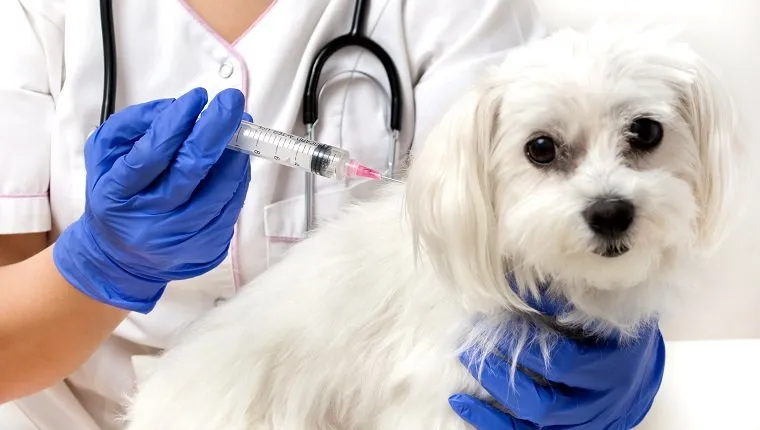Adenovirus 1 in dogs is a virus that causes respiratory infections, targets multiple organs in the body, and causes infectious canine hepatitis (ICH) — a disease that severely affects the liver and can be fatal in as many as 30 percent of the dogs who suffer from it.
This virus is the more serious of the canine adenoviruses because adenovirus 2 usually only causes minor respiratory problems. Adenovirus 1 is contagious and can spread through an infected dog’s saliva or feces. Even after a dog no longer shows symptoms of ICH, their urine can still spread the virus for six to nine months.
Vaccines to prevent adenovirus 1 infections in dogs are usually given alongside the canine distemper vaccine, as it’s one of the core vaccines recommended for all dogs except in unusual circumstances where dogs cannot receive it.
If you see the signs of an infection in your dog, then you must consult your veterinarian immediately, as it can be deadly. Here’s what you should know about adenovirus 1 in dogs.
Symptoms Of Adenovirus 1 In Dogs

The symptoms of adenovirus 1 in dogs depend on a lot of factors, including the condition of the immune system, the amount of damage the virus does to the cells, and the stage of the disease.
Infectious canine hepatitis can be mild with symptoms that are barely noticeable, or it can be severe and deadly.
Here are some of the symptoms that can appear in dogs who suffer from adenovirus 1 infection:
- Fever (usually above 104 degrees Fahrenheit)
- Loss of appetite
- Depression
- Cloudy or bluish eyes (sometimes called “hepatitis blue eye”)
- Discharge from the nose or eyes
- Glaucoma
- Upper respiratory infection
- Cough
- Tonsillitis
- Increased thirst
- Tachycardia
- Abdominal pain
- Vomiting
- Diarrhea
- Edema in the head and neck
- Jaundice
- Small red dots on the skin
- Bleeding mouth and gums
- Bruising
- Inflammation of the brain
- Convulsions
- Paralysis of one or more limbs
Causes Of Adenovirus 1 In Dogs

Adenovirus 1 infection is contagious, and the virus is quite resilient. It spreads through the saliva or feces of infected dogs, and it can still spread in the urine of dogs who recover from infection for six to nine months.
Some dogs can be carriers of the disease without ever showing symptoms of infectious canine hepatitis at all. The virus, itself, can survive for several months on its own, so contaminated surfaces or objects can still transmit the disease unless they are cleaned, preferably with bleach or harsh chemicals.
Because the virus is contagious from dog to dog, it appears more often where groups of dogs are usually together, such as dog parks, kennels, or shelters.
The disease commonly transmits to dogs through contact with infected feces, breathing contaminated airborne saliva from a sneeze or cough, contact with urine, or spending time where dogs congregate. Dogs who aren’t vaccinated, such as puppies who are too young to get the vaccination, have the highest risk of being infected.
Usually symptoms of the disease are worse when seen in puppies, and the risk of death is higher, as well.
Treatments For Adenovirus 1 In Dogs

Treatment for adenovirus 1 infection in dogs is aimed at reducing the severity of symptoms because there is no cure for adenovirus 1. Antibiotics are not effective for fighting viruses, but vets may prescribe them to reduce the risk of a secondary bacterial infection that may result from having a weakened immune system.
Vets may provide intravenous fluids to re-hydrate and restore electrolyte levels. In severe cases, dogs may need blood transfusions. Vets may also prescribe dietary changes.
Dogs may suffer tissue damage as a result of the infection, particularly in the eyes. Dogs who’ve suffered from adenovirus may have sensitivity to bright light or may experience pain in their eyes. Some vets will prescribe pain medication to reduce symptoms.
Vaccination is quite successful in reducing the risk of the disease, and it’s one of the core vaccinations recommended for all dogs. Its effectiveness may decrease with time, and the American Animal Hospital Association further recommends that dogs receive the vaccination again every three years.
You should discuss a vaccination schedule with your vet to find out what’s appropriate for your dog.
Is your dog vaccinated against adenovirus? How do you make sure your dog is safe from infections? Let us know in the comments below!









